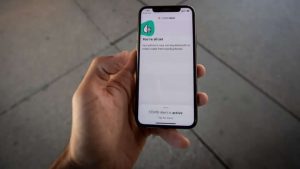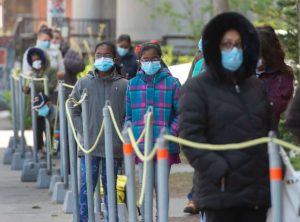Federal COVID Alert app caught 400 cases of COVID-19 in April

The federal government’s COVID Alert app sent out 35,000 exposure notifications last month that resulted in the identification of at least 400 COVID-19 cases, says Health Canada.
Just 5% of Ontario coronavirus cases used COVID Alert app to report infection
That number may not seem large when compared with the more than 165,000 cases that were recorded in April in the jurisdictions that use the COVID Alert app — but Health Minister Patty Hajdu is taking those results as a win.
“That’s over 400 chains of infection stopped with the help of COVID Alert in April,” Hajdu said in a media statement. “I encourage all Canadians to download the COVID Alert app, check it daily and keep it up-to-date.”
These new numbers provide the first indication of the effectiveness of the software, released last July and promoted by the federal government as a key tool in the fight against the pandemic.
“It looks like it seems to have had some utility,” said University of Ottawa law professor Teresa Scassa, Canada Research Chair in Information Law and Policy.
“I think they are really interesting numbers. I think they’ll help the government better be able to assess the usefulness of the app and perhaps also to identify where they will need to strengthen their work with respect to the app.”
The COVID Alert app was designed to use Bluetooth to tell users when they’ve been in close contact with someone who later tested positive.
Once someone has tested positive, the provincial public health authority is supposed to issue that person a one-time key. Once the key is entered into the app, it sends notifications to other app users who have been within two metres of the infected person for 15 minutes or more.
People who receive the notification are then instructed to seek guidance from local public health officials. In Ontario, for instance, the user is told to get tested for COVID-19 and self-isolate while awaiting results.
Built-in privacy features have made it impossible to pinpoint where the contact occurred, or with whom.
Kathleen Marriner, a Health Canada spokesperson, told CBC in an email that in April, “more than 400 users claimed a one-time key after receiving an exposure notification.” In other words, more than 400 users learned of their exposure through the app and later tested positive.

During the same month, case counts in some regions hit their highest marks since the start of the pandemic. In the parts of the country where the federal app is integrated into the health care system — the Northwest Territories and all provinces but B.C. and Alberta — 165,359 positive cases were detected.
Also in April, Health Canada said COVID Alert issued 35,000 exposure notifications, each representing a single user who was alerted to a potential contact with the virus.
“Very few things in public health are 100 per cent effective all the time,” said Susan Bondy, an associate professor in epidemiology at the University of Toronto’s Dalla Lana School of Public Health.
“It’s unfortunate we will not be able to count actual numbers of cases prevented as a result of the app, but I believe it’s not zero.”
Gathering additional data
In February, the app was reconfigured to send a package of additional data to a central server every day, according to an official with the developer, Canadian Digital Service (CDS). The official said the information was not attached to personal identifying information or a user’s IP address, which is also sent to the server.
That additional data has been telling the federal government how many active users there are per province and territory, how many exposure notifications were sent and how many one-time keys were entered, along with additional technical information that will help developers determine if the app is working properly.
More detailed statistics were expected to be published this spring, but the federal government has not announced a specific date for their release.
With the first pieces of that data now in the open, Scassa said it’s reassuring that at least some people who received a notification went out and got tested and that those tests caught infected people. But she said the app could benefit from a broader uptake.
While this first data release does offer insights into how widely the app is being used, it does not provide the whole picture.
The Health Canada spokesperson said the data are only being tracked for smartphone users that have updated to a newer version of the app and does not reflect use of the app before that feature was included.
“Data continues to be validated,” said Marriner.
Broader use required: report
While the federal government says the app has been downloaded 6.55 million times, that figure does not provide an accurate estimate of users.
According to Health Canada, COVID Alert has more than 3 million “daily active users” — less than half the total number of downloads. A few factors may account for the discrepancy. Not all users who download the app go through the short process of activating it. And others may not have updated the software in months, preventing the app from reporting data.
As of the end of March, the Canadian Digital Service, within the Treasury Board Secretariat, spent $3.5 million to develop, maintain, test and secure the app. A spokesperson for Hajdu told CBC that the federal government has not paid Apple or Google for contributing to the development of the app.
The app was launched in July of last year, but by March an interim report from a federal advisory council said that only 20,000 people had entered the one-time key that lets the app know they have the virus.
The report identified the lacklustre distribution of one-time keys as one of two problems preventing the app from achieving its potential. The second problem is that not enough Canadians have downloaded the app.
The report goes on to say that use of the app — which federal officials say is compatible with 98 per cent of smartphones — is more important at this stage of the pandemic than it was at the outset because provinces have responded so differently to the crisis.
As a first step, the report asked Alberta, B.C., Nunavut and Yukon — which have not adopted the COVID Alert app yet — to do so.
Simone Atungo, a member of a the COVID-19 Exposure Notification App Advisory Council formed ahead of the release of the app, said she rated the success of COVID Alert as “fair.” She said the technology may not have been made accessible to some frontline workers and hard-hit communities at greater risk of contracting COVID-19.
“That’s one of the key lessons that we’re learning from rolling out this app,” Atungo said. “When we’re able to successfully address barriers for the most vulnerable or marginalized people, then we’re going to be able to ensure uptake for all.”







Redes Sociais - Comentários